A guiding question focuses your research or exploration by clearly defining the central issue or problem you need to address. It shapes your investigation, helping to organize your thoughts and direct your efforts toward specific objectives. Discover how formulating an effective guiding question can transform your approach in the rest of this article.
Table of Comparison
| Aspect | Guiding Question | Inquiry Question |
|---|---|---|
| Definition | Broad, overarching question directing learning focus. | Specific, focused question driving investigation. |
| Purpose | Frames the learning objective and scope. | Encourages critical thinking and exploration. |
| Scope | General and thematic. | Detailed and precise. |
| Use in Education | Establishes context for lessons or units. | Promotes student-led research and inquiry. |
| Example | How does culture influence society? | What impact does traditional music have on cultural identity? |
Understanding Guiding Questions
Guiding questions are broad, open-ended prompts designed to direct learning and stimulate critical thinking by framing the scope of inquiry within a topic. These questions help students focus on essential concepts and develop a deeper comprehension by connecting prior knowledge with new information. In contrast, inquiry questions tend to be more specific and investigative, driving students to explore and research detailed aspects of the subject matter.
Defining Inquiry Questions
Inquiry questions are open-ended prompts designed to stimulate critical thinking and promote deep exploration within a topic. These questions encourage learners to investigate, analyze, and construct understanding through evidence-based reasoning rather than seeking simple factual answers. Defining inquiry questions involves framing them to be specific, focused, and aligned with the learning goals to drive meaningful inquiry and sustained engagement.
Key Differences Between Guiding and Inquiry Questions
Guiding questions provide a broad framework that directs the overall learning objectives and focus, while inquiry questions are more specific and designed to promote deep investigation and critical thinking within that framework. Guiding questions help structure the scope of a lesson or project, whereas inquiry questions drive student-driven exploration and discovery. The key difference is that guiding questions set the stage for learning, and inquiry questions stimulate detailed analysis and insight.
Purpose of Guiding Questions in Learning
Guiding questions direct the learning process by focusing students on key concepts and essential skills, promoting deeper understanding and critical thinking. They serve as anchors to help learners navigate content, frame investigations, and maintain focus on learning objectives. Unlike broader inquiry questions, guiding questions are specific and structured to scaffold knowledge acquisition effectively.
Role of Inquiry Questions in Research
Inquiry questions play a crucial role in research by driving deeper investigation and critical thinking, shaping the direction and scope of study beyond the broad scope offered by guiding questions. They are specific, open-ended, and designed to provoke exploration, enabling researchers to formulate hypotheses, gather detailed data, and uncover nuanced insights. Unlike guiding questions that provide a general framework, inquiry questions focus on identifying underlying causes, relationships, and implications essential for rigorous analysis and evidence-based conclusions.
How to Formulate Effective Guiding Questions
Effective guiding questions are clear, open-ended, and focused on stimulating critical thinking and exploration within a topic. Formulate guiding questions by identifying the core concept and ensuring they are specific enough to direct inquiry yet broad enough to allow multiple perspectives and deeper investigation. Using precise keywords related to the subject enhances relevance and engagement, making the guiding question a powerful tool for structured learning and research.
Strategies to Develop Strong Inquiry Questions
Effective strategies to develop strong inquiry questions include focusing on open-ended prompts that encourage critical thinking and deeper exploration, ensuring the questions are clear, specific, and aligned with learning objectives. Using Bloom's Taxonomy as a framework helps create questions that target higher-order thinking skills like analysis, evaluation, and synthesis. Incorporating student interests and real-world relevance enhances engagement and drives meaningful inquiry-driven learning experiences.
Practical Examples: Guiding vs Inquiry Questions
Guiding questions, such as "What are the main causes of climate change?" provide a clear framework to direct research and discussion in environmental science projects. Inquiry questions encourage deeper investigation, for example, "How do human activities specifically alter atmospheric composition over time?" In practical classroom settings, guiding questions outline the scope, while inquiry questions promote critical thinking and exploration beyond initial understanding.
Common Mistakes in Question Design
Common mistakes in designing guiding questions versus inquiry questions include creating overly broad or vague prompts that fail to direct focused exploration. Guiding questions should scaffold understanding and be specific enough to guide inquiry, whereas inquiry questions must promote critical thinking and deeper investigation without being too restrictive. Confusing the two often results in questions that are either too leading or too open-ended, hindering effective learning outcomes.
Choosing the Right Question Type for Your Project
Choosing the right question type for your project hinges on understanding the distinct roles of guiding and inquiry questions. Guiding questions provide a broad framework that steers the overall direction of research, while inquiry questions are more specific, designed to probe deeper into particular aspects within that framework. Opting for guiding questions fosters comprehensive exploration, whereas inquiry questions drive focused investigation, enhancing clarity and depth in project outcomes.
Guiding Question Infographic

 libterm.com
libterm.com